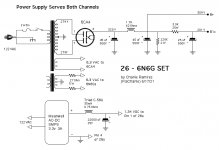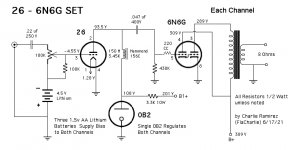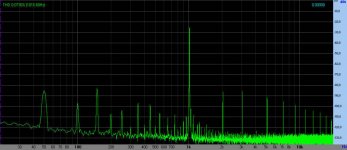Andy - great advice. I will take it. So, maybe I stay with the C3g in triode mode. If that is the case and you were in my shoes, what upgrades, if any, would you do to my circuit/parts? I am thinking about filament chokes.
FWIW: yesterday I did a shootout between RC, R, LED and battery bias for the C3g. In the end, battery bias was the best to my liking. Best tonality, richness, bite, attack. Given that the C3g is not a DHT, I was not able to try filament bias.
FWIW: yesterday I did a shootout between RC, R, LED and battery bias for the C3g. In the end, battery bias was the best to my liking. Best tonality, richness, bite, attack. Given that the C3g is not a DHT, I was not able to try filament bias.
Yes, the 1G6GT is a dual DHT.Hi FlaCharlie - thanks for chiming in on the conversation. Yes, the EML30A is the tube made by Emission Labs.
Regarding the 1G6GT, is this a twin DHT?
https://tube-data.com/sheets/127/1/1G6GT.pdf
If you need a DHT with a mu that's higher than 30, there's the 1H5GT which is a single DHT (and diode) with a mu of 65.
https://tube-data.com/sheets/127/1/1H5GT.pdf
It would be more expensive to implement than the 1G6GT, though, since it has a top cap and costs twice as much ($6). Or you could use the loctal version, which doesn't have the top cap and is $3.
FlaCharlie - good news is that my current amp is a loctal driver, so easy to change. Have you heard the 1H5Gt before? Thoughts?
Filament V=1.4. Battery for filament???
Filament V=1.4. Battery for filament???
I couldn't find a data sheet for the EML30.
EML-20A-20B-30A Data sheet. By Emission Labs.
http://www.emissionlabs.com/datasheets/SOFIA/EML30B-Curves.gif
I couldn't find a data sheet for the EML30. Is it extremely rare or are you referring to the proprietary tube made by Emission Labs called the 30A on their website? I didn't see any prices, how expensive are they?
The 1G6GTs are $3 at the dealer near me.
EML-20A-20B-30A Data sheet. By Emission Labs.
Price is apoxx 650€ per pair
I have used the 20b as power tube over 12 years and run them near 30000 hours and they measure still perfect. When you run the tubes not at maximum they will last forever
No, I haven't heard the 1H5GT yet. But, since I've had such good results using this "inverted" SET concept, I've been looking at a variety of other DH input tubes. And I like using "under the radar" tubes like the 6N6G that I'm using for outputs. As I said earlier, this setup sounds better than my Bugle 45 SET.FlaCharlie - good news is that my current amp is a loctal driver, so easy to change. Have you heard the 1H5Gt before? Thoughts?
Filament V=1.4. Battery for filament???
The 6N6G is very easy to drive so the 26 and other low mu DHTs work fine but I'm interested in checking out some of the higher mu DHTs in case I ever want to try an output tube that needs more drive. Or maybe sometime I'll try the 6N6G in PSE, which would give me 8 wpc. I also built a PP 6N6G amp, which is 10 wpc, but it uses 5751s for input / phase inverters.
I've been heating all the various DHT input tubes I've tried with a little Meanwell SMPS. It's rated at 3.3v 3A and has an adjustable output. I added a Triad C-56-U choke and a 22,000uf 25v cap (which is what I had laying around) to the output. I don't know if it really needs the additional filtering but I have no way to measure so I just tossed them in the mix. If the output voltage needs further adjustment (depending on the type of tube used) I add a resistor.
I'm using a 0B2 VR tube to supply regulated voltage to the plates which are choke loaded using cheap Hammond 156C plate chokes. I'm using battery bias on the grids.
Here's the schematics, if you're interested.
Attachments
FYI: I just ordered a set of 1LH4 triodes. $14.95 for 3 of them. Worth the cost to give them a try.
The attached data sheet has pin number 4 connected to something, but I can't tell what it is. ??? Also, the datasheet mentions a diode "The diode is located near the negative end of the filament and is independent of the triode unit except for the common filament". I am assuming this is pin number 4, correct? What is it used for?
The heater is 1.4v @ 50mA. So, I will use battery on the heater and a separate batter for grid bias most likely.
The attached data sheet has pin number 4 connected to something, but I can't tell what it is. ??? Also, the datasheet mentions a diode "The diode is located near the negative end of the filament and is independent of the triode unit except for the common filament". I am assuming this is pin number 4, correct? What is it used for?
The heater is 1.4v @ 50mA. So, I will use battery on the heater and a separate batter for grid bias most likely.
Attachments
Last edited by a moderator:
Thanks . . . I thought EML30 might be a standard tube type and I couldn't find it on Frank's. I did find the data on the EML site, but not the price. Ouch! 😱EML-20A-20B-30A Data sheet. By Emission Labs.
Price is apoxx 650€ per pair
I have used the 20b as power tube over 12 years and run them near 30000 hours and they measure still perfect. When you run the tubes not at maximum they will last forever
I've usually found Andy's impressions of various tubes to be pretty close to what I hear too but he's better at describing them. Given his comments, I wouldn't pay 65 Euros for them much less 650 ($768!).
Everyone hears things differently, though, so I'm glad you like them.
Yeah, the tube also has a diode. I assume you would just leave that pin disconnected. I'll be interested to hear your impressions of it.FYI: I just ordered a set of 1LH4 triodes. $14.95 for 3 of them. Worth the cost to give them a try.
The attached data sheet has pin number 4 connected to something, but I can't tell what it is. ???
The heater is 1.4v @ 50mA. So, I will use battery on the heater and a separate batter for grid bias most likely.
With such a low current draw a battery is certainly the simplest way to heat them. I went with the SMPS because I wanted to maintain a steady voltage on the heaters and didn't want to deal with recharging.
FYI: I just ordered a set of 1LH4 triodes. $14.95 for 3 of them. Worth the cost to give them a try.
The attached data sheet has pin number 4 connected to something, but I can't tell what it is. ??? Also, the datasheet mentions a diode "The diode is located near the negative end of the filament and is independent of the triode unit except for the common filament". I am assuming this is pin number 4, correct? What is it used for?
The heater is 1.4v @ 50mA. So, I will use battery on the heater and a separate batter for grid bias most likely.
Do you feed your amplifier from a dac? When the dac has a very low z-out its possible to use Ll7903 input transformer and use 10y as diver.
I have 2 sources: a) phono pre-amp. b) 2V DAC. Both of these are fed into a EMIA Elmaformer which provides inductive attenuation. The EMIA Elmaformer is a stereo volume control based on multiple tapped auto-transformers. The unit has 47 steps of 1.25dB each. The complete gain range is from -51.25 to +5dB.
In the Emia works the autoformer of Dave Slagle.The autoformer have a inductance of 150Hy.I use the same in my linestage but gapped for 20Hy inductance.
Yes, this is Dave's product. 150H
So, does this preclude the use of a LL7903 transformer? Like you said, if we can use the LL7903, then this opens the door to many of the low mu DHTs for drivers.
So, does this preclude the use of a LL7903 transformer? Like you said, if we can use the LL7903, then this opens the door to many of the low mu DHTs for drivers.
Yes, this is Dave's product. 150H
So, does this preclude the use of a LL7903 transformer? Like you said, if we can use the LL7903, then this opens the door to many of the low mu DHTs for drivers.
When I tried some 1:2 input transformers the loss of quality was more than any gain from using a DHT. So I went back to a good IDHT driver. I haven't tried amorphous core input transformers, which might make a difference. But even so I would expect a loss of quality. The LL7903 isn't amorphous in its usual form. It is the one Per Lundahl recommended when I emailed him. Ale Moglia and others use it.
then this opens the door to many of the low mu DHTs for drivers.
The price of pair good 1:4 SUT (for example LL7903 or Sowter 9063) at least half of EML30a ... the other half is the pair of good low mu DHT (for example 10/801).
... no free lunch...
euro21 - It's not easy to find people who have used the 30A (or 20B) from EML. I understand Andy has some reservation (re: 20B) based upon his shoot out with Ale.
So far, I have really enjoyed my EML 45B. I don't mind spending the $s on a 30A if it will be a step in the right direction compared to the C3g in my current configuration.
That said, have you used the 30A or 20B? If so, please share your thoughts on its sonic characteristics.
So far, I have really enjoyed my EML 45B. I don't mind spending the $s on a 30A if it will be a step in the right direction compared to the C3g in my current configuration.
That said, have you used the 30A or 20B? If so, please share your thoughts on its sonic characteristics.
Exactly. Which is why I'm looking forward to hearing about his experience with the 1LH4s.The price of pair good 1:4 SUT (for example LL7903 or Sowter 9063) at least half of EML30a ... the other half is the pair of good low mu DHT (for example 10/801).
... no free lunch...
If a pair of $5 DHTs with a mu of 65 can be made to work that's close enough to a free lunch when you compare it to either of the previously mentioned $800 solutions.
When I tried some 1:2 input transformers the loss of quality was more than any gain from using a DHT. So I went back to a good IDHT driver. I haven't tried amorphous core input transformers, which might make a difference. But even so I would expect a loss of quality. The LL7903 isn't amorphous in its usual form. It is the one Per Lundahl recommended when I emailed him. Ale Moglia and others use it.
Andy, you really should try one of the larger Lundahl input transformers before you dismiss input transformers as a viable option. The small transformers you tried are not it in the same class as the LL7901, 7902, 7903 and the amorphous core 1674 and 1676. With these you can use any DHT drivers with good result.
That said, have you used the 30A or 20B?
About a decade ago I develop driver for my friend with EML20A (CCS loaded).
He used it for years as (mesh anode) 300B VAS stage.
pic: CCS load, 150Vpp
Attachments
Yes, this transformers are outstanding, but your source oder preamp need a output impedance lower 500 Ohm for best sound.
The best drivers I used in my amplifier are:
(1 is best )
1 C3o in pentode mode
2 UX 210 with LL7903 input 1:4
3 EML 20AM with LL7903 input 1:2
4 26 with LL7903 input 1:4
5 C3o in triode mode LL7903 input 1:2
6 C3g in triode mode 6N7 triode
The best drivers I used in my amplifier are:
(1 is best )
1 C3o in pentode mode
2 UX 210 with LL7903 input 1:4
3 EML 20AM with LL7903 input 1:2
4 26 with LL7903 input 1:4
5 C3o in triode mode LL7903 input 1:2
6 C3g in triode mode 6N7 triode
- Home
- Amplifiers
- Tubes / Valves
- 10Y (or other DHT) replacing a C3G driver


